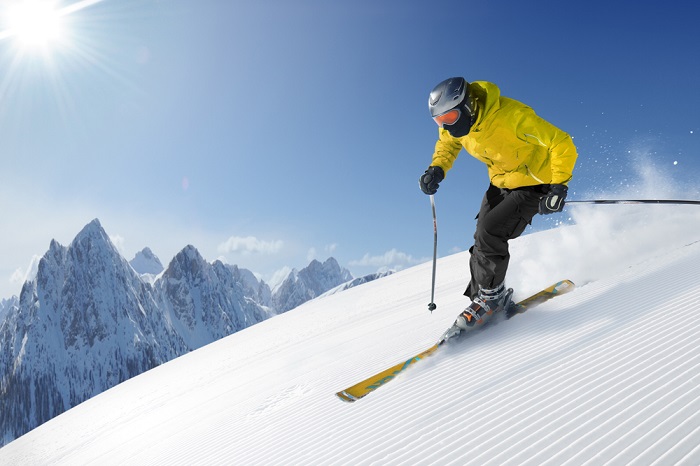Get Ready for Ski Season: Common Winter Sports Injuries and How to Prevent Them
2021-01-07

With winter finally here, many of us will be spending time outdoors doing a variety of activities. No matter which outdoor activity you’re engaged in this season, it’s important to stay warm and protect yourself from the winter sun. Dress in layers and wear clothes that fit well, that are neither too loose nor too tight. Even on cloudy days, wear a sunscreen with an SPF of at least 15. Sunlight during the winter can be surprisingly strong, especially when it reflects off the snow.
Although skiing, snowboarding, sledding, and skating can be lots of fun, they can also be dangerous. For that reason it’s important that we take certain steps to ensure we have a fun and safe winter this year.
Skiing and snowboarding
- Only use equipment that fits you well. Equipment that is too big for you will be difficult for you to control. Ski boots that are designed for kids are more flexible than those designed for adults and have buckles that are easier for younger hands to manage.
- Ensure you have the proper accessories. Helmets are a must, as well as goggles. Goggles not only protect your eyes from the sun, but also from anything that may get in your eyes, such as bits of snow or ice. Snowboarders may also consider using knee and elbow pads to protect their joints during falls.
- Learn the basics from a qualified instructor. Take lessons, particularly in the beginning, to teach you how to steer and stop properly. Your instructor will also help you decide which trails are appropriate for your level. If in doubt, stick to the easier trails and work up to the harder ones later on.
Sledding
- Use a sled that is well-made. Ensure that it’s sturdy and easy to steer. The handholds should be easy to grab and the seat should be padded. Never use a homemade sled, such as a garbage can or plastic bag, as these can be dangerous and cause you to lose control. If you’re using an older sled, inspect it for any sharp points, jagged edges, or broken parts.
- Dress appropriately. Gloves or mittens and boots not only keep your hands and feet warm, but they also protect you from getting hurt. Wearing a bike helmet is also a good idea as head injuries while sledding are possible.
- Choose your sledding spot carefully. Make sure the trail doesn’t end near a road and that there aren’t obstacles such as trees, bushes, or rocks, in your way. The slope shouldn’t be too steep and should be covered with packed snow rather than ice. It’s important to sled only during the day or in well-lit areas at night.
- Be extra careful when sledding with others. If two people will riding together, ensure that you don’t exceed the maximum weight recommended for the sled. This information can usually be found on a sticker on the bottom of the sled. If you’re sledding with a bunch of other people, make sure that the person in front of you is far enough down the slope before you start so that you don’t crash into each other.
Skating and ice hockey
- Only skate on ice that has been inspected and approved. If a safe area has been blocked off, make sure you stay inside that special area. Ice that looks strong may not be able to hold your weight and you could end up falling through.
- Make sure that your skates fit properly. Skates should neither be too tight nor too loose, and should always be fully laced up to the top.
- Use the proper gear when playing hockey. This includes padding and a special helmet made for ice hockey.
- Pay attention while you’re skating. Skate in the same direction as everyone else. Watch where you’re going and make sure you have plenty of room around you and aren’t getting too close to others.
- Don’t skate with gum or candy in your mouth. You could choke or accidentally drop your gum or candy on the ice cause another skater to trip.
If, however, despite taking appropriate steps to have a safe winter season you still get injured, the following are some basic first aid techniques you can apply:
- Immediately discontinue the activity to prevent further injury.
- Apply an ice pack to the injured area for the first 24 to 48 hours to reduce swelling and raise up your leg
- Use a bandage or brace on the injured to area to immobilize it and prevent further swelling. Be careful, however, of applying the bandage too tightly as this can cause more harm than good!
- Consider taking over-the-counter anti-inflammatory medicine, such as ibuprofen, to temporarily relieve pain and reduce swelling.
If you suspect that your injury is more serious, however, the team here at ParkwayHealth is here to offer comprehensive and immediate assistance to not only treat your injuries, but also to help you with your recovery, manage your pain, and provide you with advice on how to avoid injury in the future. All of our family physicians across our medical network are qualified to provide urgent medical care, to set fractured bones, and to stitch lacerations in the event of minor emergencies whenever they occur.
In addition, we have leading orthopedic and sports medicine specialists on staff to deal with a wide range of complex, general, and sports-related injuries affecting the musculoskeletal system. If you find yourself suffering from a sports injury this season, call our Appointment Service Center at 400 819 6622 today to schedule an appointment with a specialist.
Article reviewed by Dr. David Jiang, Orthopedic Surgeon at ParkwayHealth






























